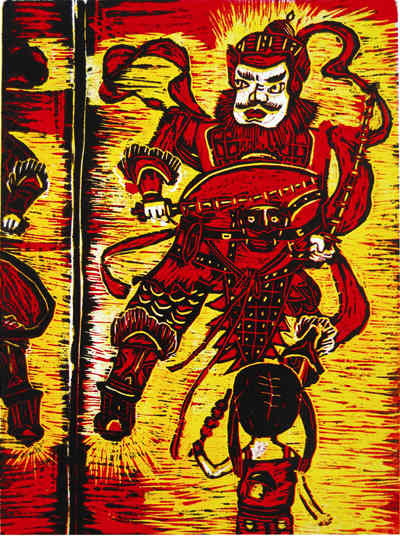|
 |
|
Dialogue, a wood engraving piece, made by 11-year-old Li Xinyu (ZHAO JIANYONG) |
Benefiting from engraving
Xinhualu Primary School started to offer engraving and physical education courses in 1994 to increase extra-curricular activities for their students. In the process of teaching engraving, teachers realized that it improves children's aesthetic taste as well as their creativity.
Zhao Jianyong, head of the fine arts teaching and research group at Xinhualu Primary School, hopes to expand his students' creativity by teaching them how to engrave. He said he encourages his students to think outside the box.
"Compared with other forms of painting, the process of engraving is more complicated," Zhao said.
"In addition, it takes a longer time to make an engraving, which trains the students to be patient and persistent."
He added that making engravings enables different parts of the body to coordinate better with each other and creates more dexterous hands and sharper eyes.
Furthermore, engravings arouse students' curiosity and build a sense of teamwork. Zhao once organized students of six classes to work on one engraving. During the process, every child did his or her share of work and cooperated with each other, realizing both their individual value and experiencing the pleasure of teamwork.
Nurturing creative thinking
At an exhibition held at the Guangzhou Academy of Fine Arts in October, factoryproduced products based on paintings created by children were on display.
Yang of the Yang Zhiguang Fine Arts Center said that the youngsters' paintings look naive and perhaps foolish and are easily ignored by their parents. However, once turned into a product those perceptions could change.
Yang's father, Yang Zhiguang, a renowned contemporary Chinese painter, said, "Many years ago I lived with my daughter in the United States after retirement and saw 'made in China' on many products. I wondered why these products were 'made in China' instead of 'designed in China.' Then I made a decision to come back to China with my daughter and started this center to train children in creative thinking."
"Fine arts education today is aimed at cultivating creative thinking, and in order to achieve this goal, we should develop the observational, imaginative and creative abilities of the children at an early age," the 82-yearold man said.
Yang's fine arts center has opened dozens of branch schools in China and has been widely praised by parents and educators alike.
The younger Yang said the purpose of a fine arts education is not to improve, for example, drawing skills, but to train children to think creatively. Children could draw a beautiful painting with consummate skills, but this kind of painting may not have much value if no creative ideas are involved.
She pointed out that children whose parents encourage creative thinking will be much more fully developed.
"The exam-oriented education has evaluated students by their scores, overlooking their creativity," Yang said. "Our purpose is to make their extra-curricular lives more colorful to complement the current education."
Email us at: tangyuankai@bjreview.com | 